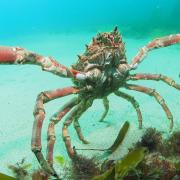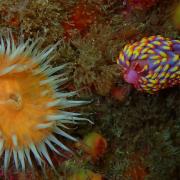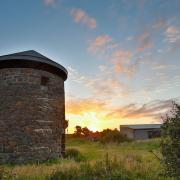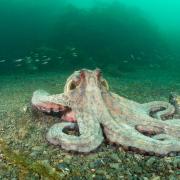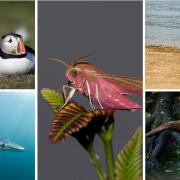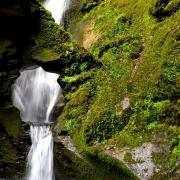The dipper and the grey wagtail are experts at living by fast-flowing water. Cornwall Life looks at their traits and where to spot them around the county. Words and pictures by David Chapman
The dipper and the grey wagtail are experts at living by fast-flowing water. Cornwall Life looks at their traits and where to spot them around the county.
Words and pictures by David Chapman
Life in the water is difficult; just maintaining a foothold is hard enough but finding anything to eat is quite simply a specialist job. But there is food to be found, and where there’s food there’s a specialist feeder which has adapted to finding it.
Many types of bird have strong associations with their habitat but few are as particular and inseparable as the dipper and grey wagtail. Throughout the year, the dipper exists only in fast-flowing rivers and streams, and though some grey wagtails venture into other wetland areas, all upland rivers have their fair share of these distinctive birds.
Strangely enough, both species share a further trait, one that is behavioural and reflected in both of their names – they both bob. The dipper bobs its entire body, whereas the grey wagtail bobs its tail. Some suggest that the dipper gains a more three-dimensional image of its surroundings by continually changing the position of its eyes, but this is not true of the wagtail. Others think that the constantly moving white breast of the dipper, or yellow tail of the wagtail, might mesmerise its prey. Another possibility is that the movement might be a form of communication; the river is often a noisy place where the birds’ calls might not carry as well as sight.
One further possibility for this movement is that it might aid the birds’ camouflage. The movement of a dipper’s breast definitely mimics the constantly changing reflections of light and shade on the surface of a fast-flowing river. Whatever the reason for the evolution of this behaviour, I suspect that it is common to both species since they live in such a similar environment. However, although they share habits and habitat, there are differences between the two.
The dipper is quite unlike any other British bird; it pushes the boundaries of bird behaviour beyond that which many people think possible. It may seem a shy bird but it is predictable in its choice of habitat, so it is relatively easy to find.
Entirely restricted to streams and fast-flowing rivers, usually in upland areas, the dipper rarely, if ever, strays more than a few feet from the river’s surface throughout its life.
The name dipper, along with local names including ‘bobby’, probably refers to the dipper’s relentless bobbing stance, though it could refer to the bird’s habit of dipping into the water. It is fairly rotund, about the size of a blackbird, with a well-rounded belly and good, thick plumage. With its well-waterproofed feathers, it must be one of our most buoyant species, yet it walks under water in search of its prey.
The diet of the dipper consists mostly of insects, such as damselfly larvae and water beetles, but it also eats small fish. Its prey seek safety in the fast-flowing water by hiding away under pebbles and in gravel on the river bed. The dipper needs to submerge itself in treacherous conditions, while being able to disturb the stones by scratching around with its feet to reveal its prey. How it remains submerged is a simple yet brilliant tactic. It uses the force of the fast-flowing water by angling its wings and body against the current to create a downward pressure, negating its own buoyancy.
At this time of year the food is more likely to be for its growing young than for its own consumption. The dipper makes its dome-shaped nest under bridges, among the rocks, or in other cavities such as those around eroded tree roots. It usually nests early in the season, so by now its young will probably have fledged, though they will be dependent upon their parents for some of their food. Young dippers closely resemble their parents in shape and size but have a scalloped pattern to their plumage and less white on their breast. It will be a couple of months before the young birds moult into their adult plumage which, despite appearing as a black back and white breast, comprises of a chestnut head and belly.
The grey wagtail is shaped like the more familiar pied wagtail but it has an even longer tail that wags continually. During the spring and summer, grey wagtails are always associated with water; they prefer fast-flowing rivers but can also be found around lakes and slower rivers. In winter, grey wagtails can be found in a much wider range of habitats including small garden ponds, the strandline of beaches and even the roofs of houses.
During April, grey wagtails will be making a nest in a crevice, possibly in an old wall adjacent to the river or maybe in a gap amongst tree roots. To find food, the wagtail is not as adventurous as the dipper; instead of walking underwater it settles for finding insect prey on rocks and in the air. Its airborne sallies are easier to watch than the underwater antics of the dipper and every bit as impressive.
There is no point in looking for either of these two species away from fast-flowing rivers. The River Fowey is a great one, with Golitha Falls being another beautiful place where both birds can be seen. Further downstream, try looking into the river if you are visiting Respryn Bridge (Lanhydrock) and even as far as Lostwithiel. In the west of Cornwall, Kennall Vale, a Cornwall Wildlife Trust reserve near Ponsanooth, is a lovely place to visit and a good spot for these birds.









